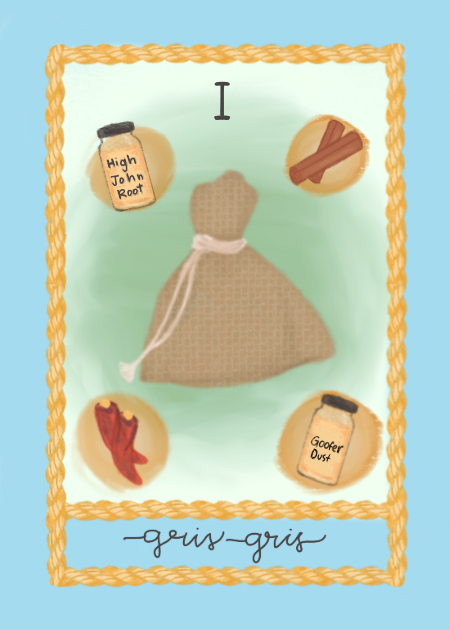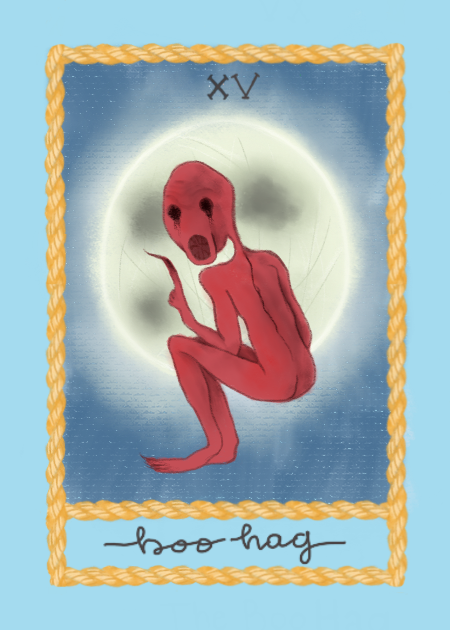Artist Statement
Hoodoo, also called conjure or root work, evolved with elements from Kongo, European, and Indigenous beliefs across the United States — mostly in the South. With this project, I want to focus specifically on what Hoodoo looks like in the Lowcountry of South Carolina specifically amongst the Gullah Geechee people. As a practice that is borne out of resourcefulness and making do with the tools at one’s disposal, it’s not uncommon for practitioners of Hoodoo to use tarot and other tools that might not be African in origin to aid them. In the same vein, reimagining the tarot deck with imagery unique to Gullah Geechee culture mirrors the versatility of Hoodoo itself.
Although each card has its own significance and meaning, there are still common threads running between them. The blue background of the cards is referencing the prevalence of haint blue paint across the Lowcountry. Seen across porches, window frames, and in blue glass bottles on bottle trees, this color is used to ward off evil spirits from one’s home — and tarot deck. The texts by Charles Joyner, Ras Michael Brown, and Yvonne Chireau heavily influenced the boo hag, mermaid, and gris gris cards. Other texts like the Sorcerers of Knowledge Spell Book and Rituals of Resistance were referenced throughout the entire process of creating these cards, and helped to shape their tone and the imagery featured in them. In his book, Jason R. Young says that the institution of slavery was not just about forced labor but also encompassed an ideology of subjugation that was enforced across all aspects of living — religion, politics, economics, etc. Thus, the act of rebelling against this institution happens across many lines. For this reason, I wanted to include imagery, such as the sweetgrass basket, that may not have any ritual importance in Hoodoo specifically but are unique to the culture of the Gullah Geechee people and callbacks to the traditional way of being before enslavement. Just as Hoodoo is a representation of the resiliency of the African diaspora, other objects like the sweetgrass basket show how Black people hold on to cultural memories at risk of being lost to White supremacy.
Many of the texts I referenced in this project had stories and ideas that felt very familiar to me. The accounts of hags in Joyner’s book mirrored exactly the descriptions of the boo hags I had been accustomed to growing up and shaped the tarot card which I reimagined as the boo hag. The Lowcountry is full of different waterways and the impact of the Atlantic Ocean and the different bodies of water running through the landscape on the formation of Gullah culture and history is undeniable. Chapter 3 of Brown’s book, with its discussion of water spirits and mermaids, exemplified the importance of water in Lowcountry Hoodoo. The mermaid tarot card, representing justice, was directly based off of the mermaid story featured in this chapter. Chireau’s Black Magic contains in depth discussion about the general history of Kongo traditions and their relevance in African American practices. The manifestation of minkisi in Lowcountry Hoodoo as gris gris and the importance of this aspect of Hoodoo is talked about extensively in Chapter 2 of this book, and also shaped the creation of the gris gris tarot card.
Although not a full deck of cards, in these four images and the accompanying descriptions I want to show different aspects of Hoodoo across the South and particularly the cultural variations of this religion seen amongst the Gullah Geechee people of South Carolina. Even though my family is not Geechee, I was born and raised in South Carolina and the particular practices and stories coming from this culture surrounded me in my everyday life growing up. Throughout the process of creating these cards and reading about everything Gullah Geechee and Hoodoo I gained an even deeper appreciation and love for the Lowcountry, South Carolina, and the indelible impact left on this land by my ancestors.
Brown, Ras Michael. African-Atlantic Cultures and the South Carolina Lowcountry, Cambridge University Press, 2012. ProQuest Ebook Central, https://ebookcentral.proquest.com/lib/agnesscott/detail.action?docID=989109.
Chireau, Yvonne P. Black Magic: Religion and the African American Conjuring Tradition, University of California Press, 2003. ProQuest Ebook Central, https://ebookcentral.proquest.com/lib/agnesscott/detail.action?docID=223936.
Failla, Marcelitte. Sorcerers of Knowledge: A Spell Book. PDF, https://static1.squarespace.com/static/5a53fccb2aeba5a4ebc166ee/t/5a5409b7c83025ac91c4673a/1515457009339/Sorcerers+of+Knowledge.pdf.
Joyner, Charles. “Come by Here Lord.” Down by the Riverside: A South Carolina Slave Community. University of Illinois Press, 1994. 141-71. Print.
Young, Jason R. Rituals of Resistance: African Atlantic Religion in Kongo and the Lowcountry South in the Era of Slavery. Louisiana State University Press, 2011. Print.
Tarot Cards

Keywords: Manifestation, agency, creation, communication

Keywords: Tradition, spirit guides, education

Keywords: Justice, balance, truth

Keywords: Oppression, entrapment, denial of agency
